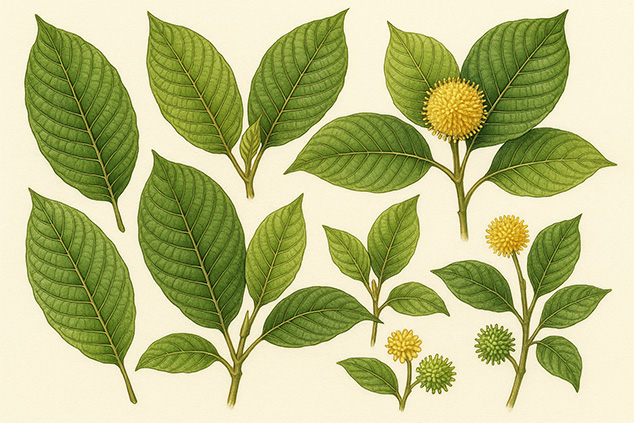While Mitragyna speciosa has hogged the limelight in the west, it’s not the only variety of the Mitragyna genus that exists. In fact, there are seven distinct known varieties of Mitragyna. Yet, are they the same? Could you use other plants from the Mitragyna genus as kratom alternatives? Let’s learn more and find out.
The Rubiaceae Plant Family
Scientists estimate that there are approximately 400 thousand different species of plants that are currently known to us. To classify them, scientists use plant taxonomy, a science of classifying plants. Each plant belongs to a division, class, order, which are rather wide, as well as family, genus, and species, which are more specific.
When it comes to our beloved Mitragyna speciosa, it belongs to the Angiospermae division of plants that includes flowering plants and the clade of asterids, which includes such popular plants as tomatoes, forget-me-nots, potatoes, peppers, sunflowers, Brazil nut, lavender, lilac, and olive.
Next, Mitragyna speciosa is a member of the Gentianales order and the Rubiaceae family, which includes around 80% of the plants in the order.
Rubiaceae plant family is better known as the Madder or Coffee family of plants. This family mostly includes shrubs, but there are also trees, herbs, and lianas in it. There are approximately 600 different genera and over 13 thousand plant species, most of which grow in tropical and subtropical climates.
In addition to the Mitragyna genus, the Rubiaceae family also includes such plants as the coffee shrub, the Chinchona, which is the source of the antimalarial alkaloid quinine, and the ornamental plant Gardenia.
The Mitragyna Genus
1. Mitragyna Speciosa
The most well-known variety of the Mitragyna genus is the speciosa variety, which we refer to as kratom. It grows in various Southeast Asian countries, namely in Indonesia, Malaysia, Thailand, Myanmar, and Papua New Guinea.
Mitragyna speciosa trees are tall, reaching around 82 feet of height. The most prominent alkaloids in this variety are mitragynine and 7-hydroxymitragynine. They are responsible for kratom’s famous pain-relieving, relaxing effects, mood-boosting, and stimulating effects.
Kratom has a wealth of other alkaloids as well as beneficial compounds, which include polyphenols and flavonoids. Scientists believe that this variety possesses approximately 40 different compounds, including 25 alkaloids. Yet, its full profile is currently not known, and the herb may have more than that.
2. Mitragyna Diversifolia
Also called Mitragyna javanica, this variety of the Mitragyna genus is an understory tree. Mature trees reach approximately 49 feet of height and are nearly half the size of Mitragyna speciosa trees.
Mitragyna_diversifolia grows in several Asian countries, which include Thailand, China, Cambodia, Laos, Vietnam, Myanmar, and the Philippines.
This Mitragyna genus variety does not contain either mitragynine or 7-hydroxymitragynine. However, it is rich in the alkaloid mitrajavine. This alkaloid is also present in speciosa, yet in considerably lower amounts than mitragynine. While no pharmaceutical studies have been performed on this variety, some reports state that it has mild relaxing properties which are much weaker than those of speciosa.
Despite the lack of the pain-relieving properties that you can expect from speciosa, some vendors offer it as a kratom alternative. Keep in mind that you will not be able to gain the same effects, though. This tree is normally used for timber.
3. Mitragyna Hirsuta
Found across Vietnam, Cambodia, and Thailand, Mitragyna hirsuta is another species in the Mitragyna genus.
Unlike Mitragyna speciosa, which is rich in alkaloids mitragynine and 7-hydroxymitragynine, the dominant compound in Mitragyna hirsuta is mitraphylline. This alkaloid is also present in Mitragyna speciosa and the bark of Cat’s claw.
Some studies performed on this alkaloid show that it can serve as an anti-inflammatory and anti-cancer agent.
Despite the beneficial properties of this alkaloid, the effects of Mitragyna hirsuta are not equivalent to those you can expect from speciosa. Some users report experiencing mild relaxing effects as well as headaches, others none at all. So, it’s best that you do not try it as an alternative to kratom.

4. Mitragyna Inermis
Mitragyna inermis is a bushy shrub or a tree that reaches about 50 feet in height. Unlike other Mitrogyna genus trees, it grows in the African continent.
A variety of alkaloids are present in the leaves of this variety, yet it does not have mitragynine or 7-hydroxymitragynine. Locals use this tree as wood and plant dye.
5. Mitragyna Parvifolia
This species of the Mitragyna genus grows in India and Sri Lanka and reaches around 50 feet of height when mature. People in these locations use it as wood.
Some of the alkaloids present in this variety, such as mitraphylline, are also present in kratom. However, this variety doesn’t have the primary kratom alkaloids 7-hydroxymitragynine and mitragynine. Locals use this plant in traditional medicine to treat jaundice and inflammatory conditions such as swelling, fever, ulcers, and similar.
While this variety has some beneficial uses and effects, they are not identical to those of kratom.
6. Mitragyna Rotundifolia
Indigenous to Vietnam, Laos, Thailand, Myanmar, China, India, and the Philippines, this tree’s primary alkaloids are completely different from those found in other Mitragyna species. Nonetheless, studies have indicated that this variety has antibacterial, antioxidant, antidiabetic, and liver-protecting properties.
While these can be potentially beneficial, this species does not offer the same effects as Mitragyna speciosa.
7. Mitragyna Tubulosa
This Mitragyna species grows across India and Sri Lanka. The leaves of the tubulosa are rich in mitracilliatine, an alkaloid different from mitragynine or 7-hydroxymitragynine. Yet, there are few reports on the effects and properties of this alkaloid, and beneficial uses of this tree are not currently known.
Conclusion
While Mitragyna speciosa isn’t the only tree in the Mitragyna genus and, apart from being considerably taller when mature, it’s visually not much different from the other varieties. Yet, the alkaloid profile of each tree is vastly different.
While each individual variety has beneficial properties, the other Mitragyna varieties won’t provide the same effects as Mitragyna speciosa and won’t be as effective alternatives.
Have you tried other varieties of the Mitragyna genus? What has your experience been, and what effects, if any, have you felt?



Leave a Reply